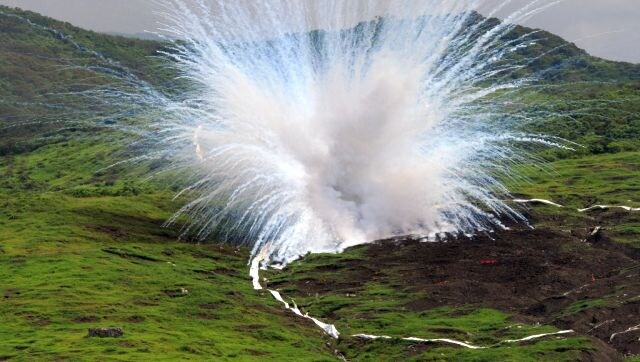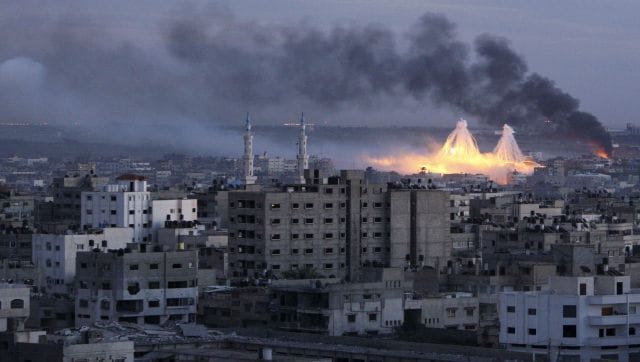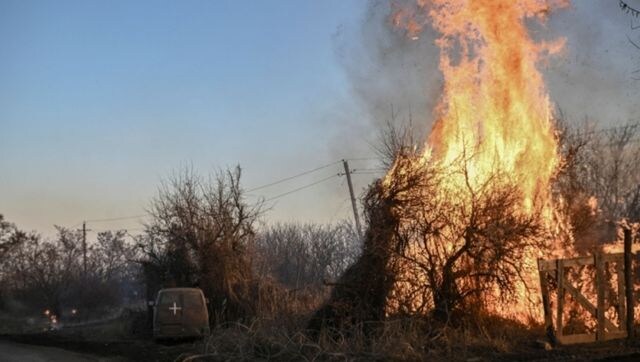Russia ‘fires’ white phosphorous bombs in Ukraine: What are these deadly munitions that ‘rain down hell’?
White phosphorous bombs, classified as incendiary weapons, are highly inflammable when exposed to oxygen and disseminate heavy white smoke. They can cause grave harm through burns. While Russia has been accused of firing them in the Ukraine war, the US, Israel and Turkey have used them in the past

White phosphorous bombs generate a flame of up to 1,300 degrees Celsius, accompanied by dense, white smoke. They are deadly when used and United States, Israel, Syria and Turkey have previously caused controversy with their alleged use. AFP
Approximately a half hour away from the city of Bakhmut in Ukraine’s east, where fighting continues relentlessly, lies the town of Chasiv Yar, which has been battered by constant Russian bombing and shelling.
On Tuesday, AFP reporters on the ground said that they witnessed white phosphorus munitions being fired from Russian positions around 4:45 pm (local time) on a road at the southern edge of Chasiv Yar leading to nearby Bakhmut. They stated that the explosions released small, burning balls of white phosphorus that slowly fell to the ground and the balls set fire to the vegetation on both sides of the road on a surface equivalent to the size of a football pitch.
Incidentally, this isn’t the first time that Russia has allegedly used white phosphorous munitions in the war in Ukraine that has entered its second year. Earlier in March last year, Ukraine’s president Volodymyr Zelenskyy had claimed that Moscow had used white phosphorus against civilians in his country. Then again in May 2022, Russian forces had reportedly used this kind of weaponry in their efforts to capture the Azovstal steel plant in Mariupol.
⚡️⚡️Urgent! Azovstal is being bombed with phosphorous bombs#UkraineUnderAttack #SaveAzovstal pic.twitter.com/aSGo0b4QCF
— Anton Gerashchenko (@Gerashchenko_en) May 15, 2022
But what are white phosphorous bombs? How dangerous are they? And why have countries banned its use?
What are white phosphorous bombs?
White phosphorous bombs are, as the name suggests, those that combine a mixture of white phosphorus and rubber. White phosphorus is a wax-like chemical substance, often yellowish or colourless, that some people say smells like garlic.
Other common names for white phosphorus munitions include WP and the slang terms Willie Pete and Willie Peter, which are derived from William Peter.
White phosphorous ignites instantly when it comes into contact with oxygen, and its primary function in weaponry is to burn, fast and bright. It is used in incendiary munitions by militaries around the world, including the United States, often to illuminate targets as part of tracer munitions at night. White phosphorus is also used to create smokescreens during the day, as it puts off a huge amount of smoke when it burns.
According to Dan Kaszeta, an associate fellow at the Royal United Services Institute, this is why phosphor remains “one of the fastest ways to make highly dense and effective smoke screens.”

How dangerous are WP bombs?
White phosphorous is highly toxic and according to Human Rights Watch, a leading watchdog organisation, is notorious for the severity of the injuries it causes. The chemical ignites on contact with oxygen and is highly soluble in fat, meaning it grievously burns human flesh.
“If it lands on somebody, it burns very, very vigorously,” Hamish de Bretton-Gordon, a former commander of the United Kingdom’s and NATO’s chemical, biological and nuclear defense forces, was quoted as telling NBC News.
Experts cite that white phosphorous sticks to many surfaces, including skin and clothing, making it difficult to wash off — leading to the injuries to be graver. Dr Rola Hallam, a physician who treated incendiary weapons victims in Syria, in a Human Rights Watch said: “They cause devastating burns, and in far worse ways than any of the standard scald or fire burns. “They can burn through everything. If they can burn through metal, what hope does human flesh have?”
What makes it even deadlier is that it cannot be put out with water and burns at up to 1,300 degrees Celsius.

Scholars David Barillo, Leopoldo Cancio, and Cleon Goodwin in the Burns Journal elaborating what makes white phosphorous so dangerous write that they cause burns that damage bones, form deep wounds — taking longer to heal than regular burns. Primarily, these bombs make the body vulnerable and weak for a long time, increasing the chances of other infections and diseases.
White phosphorous can also seep into the bloodstream, poisoning the kidneys, liver, and heart and causing multiple organ failure. According to the HRW report, which compares it to Napalm, the fumes released in white phosphorus attacks can also injure or severely irritate the eyes and make them highly sensitive to light. Exposure to white phosphorus can also result in facial paralysis, seizures, and fatal heartbeat irregularities.
Also read: Does the ICC hold power to punish Russians for war crimes in Ukraine?
Have they been used in the past?
The short answer to this is yes. White phosphorus shells were widely used in World War II, especially by American troops fighting German armoured forces in the European theatre.
In 2004, US forces were accused of using phosphorus bombs in their 2004 assault on the Iraqi city of Fallujah. At the time of the attack, no Western journalists had reported the news. However, Islam Online website wrote: “US troops are reportedly using chemical weapons and poisonous gas in its large-scale offensive on the Iraqi resistance bastion of Fallujah, a grim reminder of Saddam Hussein’s alleged gassing of the Kurds in 1988.”
A year later, a spokesman for the US military admitted to the use of white phosphorus bombs. Lt-Col Barry Venable had then told BBC, “White phosphorus is a conventional munition. It is not a chemical weapon. They are not outlawed or illegal.”
There are also cases of white phosphorous bombs being used during the US-Taliban clashes of 2009 in Afghanistan. The US and Taliban traded charges of using the dangerous munition against each other.
In the same year, there was extensive reporting on Israel’s use of white phosphorus munitions in Gaza, from 27 December 2008 to 18 January 2009, named Operation Cast Lead. In a 71-page report, Human Rights Watch said the repeated use of white phosphorus artillery shells in populated areas of Gaza was not incidental or accidental, but revealed “a pattern or policy of conduct”.
It said the Israeli military used white phosphorus in a “deliberate or reckless” way.

“In Gaza, the Israeli military didn’t just use white phosphorus in open areas as a screen for its troops,” said Fred Abrahams, a senior Human Rights Watch researcher. “It fired white phosphorus repeatedly over densely populated areas, even when its troops weren’t in the area and safe smoke shells were available. As a result, civilians needlessly suffered and died.” Four years later, Israel announced that it would no longer use artillery shells with white phosphorus to create smokescreens on the battlefield.
Armenia and Azerbaijan have each accused the other of using phosphorus weapons in their war over Nagorny Karabakh in 2016 as well as 2020.
Kurdish authorities in northeastern Syria have also accused Turkey of resorting to white phosphorus munitions — a charge that Ankara has refuted. The Kurdish leaders were quoted as saying then: “The Turkish aggression is using all available weapons against Ras Al-Ain. Faced with the obvious failure of his plan, (Recep Tayyip ) Erdogan is resorting to weapons that are globally banned, such as phosphorus and napalm.”
In the ongoing Russia-Ukraine war, Kyiv has accused the Vladimir Putin-led government of using this deadly munition on several occasions. The first time such a claim was made was a month into the war.
Emina Dzheppar, Ukraine’s deputy foreign minister, also tweeted a video in March showing a rain of lights in a dark sky. “Invaders used phosphorus bombs. When it explodes, it disperses a substance with a more than 800 degrees combustion temperature,” Dzheppar wrote.
#Popasna, Lugansk vilâyeti. 🇷🇺işğalcileri fosfor bambalarını qullandı. Patlağanda yanma arareti 800 dereceden çoq olğan bir madde tarqata. Zarar körgen mıntaqa bir qaç yüz kvadrat metrni teşkil ete. Olarnıñ qullanması halqara qanunlarınen yasaq etilgen pic.twitter.com/UrVxZlRMPt
— Emine Dzheppar (@EmineDzheppar) March 13, 2022
In July last year, similar claims were made again, with Ukrainians sharing videos on Twitter of reportedly Russian jets dropping several bombs containing white phosphorus on Snake Island.
Is it legal or a war crime?
Owing to its incendiary nature, the use of phosphorus in war is supposed to be tightly regulated under international law — but it is not banned. They have been categorised as incendiary weapons and their use is regulated through Protocol III in the Convention on Certain Conventional Weapons (CCW), signed in Geneva and enforced since 1983.
According to the Protocol III, the use of white phosphorous against civilians and civilian structures is prohibited. However, there are loopholes in the definition of incendiary weapons. The definition excludes those that can be of multipurpose usage and it imposes weaker restrictions for those launched from the ground.
This has led to calls to strengthen the law, but until then their use remains murky in war and conflict.
With inputs from agencies
Read all the Latest News, Trending News, Cricket News, Bollywood News,
India News and Entertainment News here. Follow us on Facebook, Twitter and Instagram.
also read

Russia 'fires' banned white phosphorus munitions in eastern Ukraine
Weapons containing phosphorus are incendiary arms whose use against civilians is banned, but they can be deployed against military targets under a 1980 convention signed in Geneva

White phosphorus munitions fired in eastern Ukraine
Two projectiles were fired five minutes apart at around 4:45 pm (1445 GMT) on a road at the southern edge of Chasiv Yar leading to nearby Bakhmut, as seen by AFP journalists
